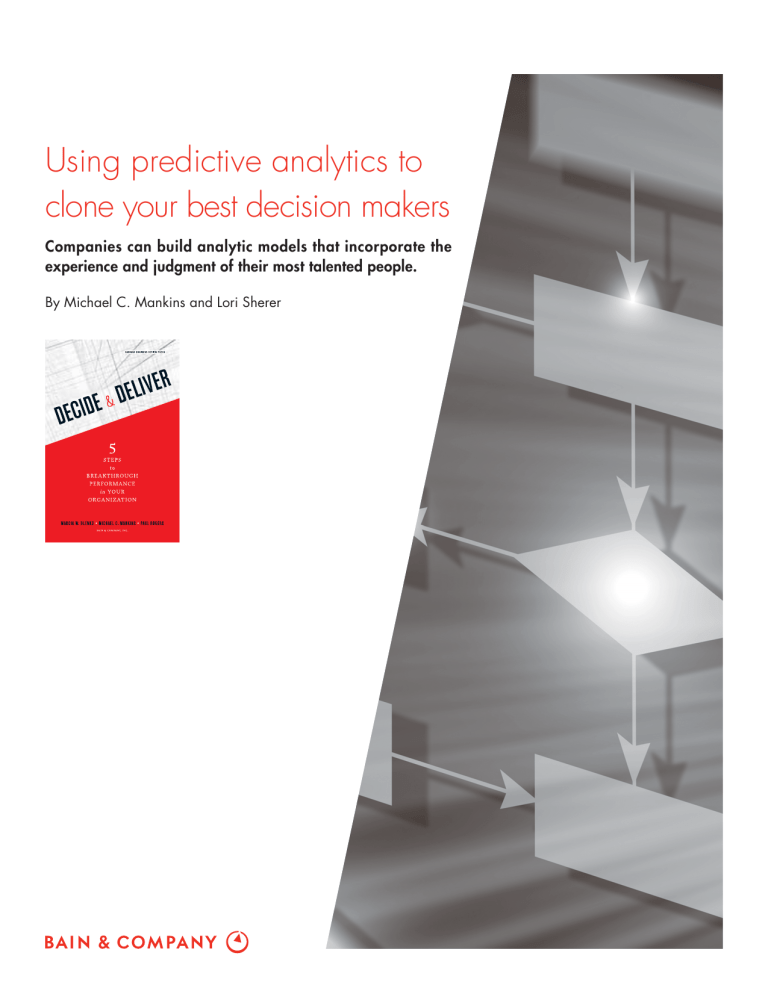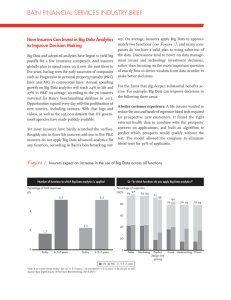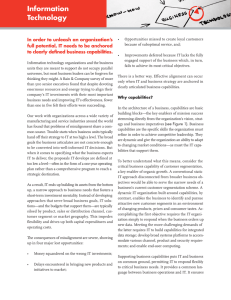
Using predictive analytics to
clone your best decision makers
Companies can build analytic models that incorporate the
experience and judgment of their most talented people.
By Michael C. Mankins and Lori Sherer
Using predictive analytics to clone your best decision makers
Any company’s decisions lie on a spectrum.
On one end are the small, everyday decisions that add
up to a lot of value over time. Amazon, Capital One
and others have already figured out how to automate
many of these, like whether to recommend product
Midlevel decisions represent a potential gold mine for the companies that
get there first with advanced analytics.
B to a customer who buys product A or what spending limit is appropriate for customers with certain
characteristics.
This is not so much crunching data as simulating a
human process.
On the other end of the spectrum are big, infrequent
strategic decisions, such as where to locate the next
What happens? The need for human knowledge and
$20 billion manufacturing facility. Companies assem-
judgment hasn’t disappeared—you still require skilled,
ble all the data and technology they can find to help
experienced employees. But you have changed the
with such decisions, including analytic tools such as
game, using machines to replicate best human prac-
Monte Carlo simulations. But the choice ultimately
tice (see
depends on senior executives’ judgment.
to results that are:
In the middle of the spectrum, however, lies a vast
•
Figure 1). The decision process now leads
Generally better. The incorporation of expert knowl-
and largely unexplored territory. These decisions—
edge makes for more accurate, higher-quality
both relatively frequent and individually important,
decisions.
requiring the exercise of judgment and the application of experience—represent a potential gold mine
•
ity of decision outcomes.
for the companies that get there first with advanced
analytics.
Imagine, for example, a property-and-casualty company that specializes in insuring multinational corporations. For every customer, it might have to make
risk-assessment decisions about hundreds of facilities around the world. Armies of underwriters make
these decisions, each underwriter more or less
experienced and each one weighing and sequencing
More consistent. You have reduced the variabil-
•
More scalable. You can add underwriters as your
business grows and bring them up to speed more
quickly.
In addition, you have suddenly increased your organization’s test-and-learn capability. Every outcome
for every insured facility feeds back into the modeling process, so the model gets better and better. So
do the decisions that rely on it.
the dozens of variables differently.
Using analytics in this way is no small matter. You’ll
Now imagine that you employ advanced analytics to
codify the approach of the best, most experienced
underwriters. You build an analytic model that captures their decision logic. The armies of underwriters then use that model in making their decisions.
find that decision processes are affected. And not only
do you need to build the technological capabilities,
you’ll also need to ensure that your people adopt
and use the new tools. The human element can sidetrack otherwise promising experiments.
Using predictive analytics to clone your best decision makers
Figure 1: Traditional decision making vs. decision making with advanced analytics
Advanced analytics model
Decision
makers
Analytical
decision model
Decision
outcomes
Test and learn
Decision
outcomes
Individual
decision logic
Decision
makers
Traditional model
Capacity constraints and outcomes
vary by decision maker
More scalable model, with better and more
consistent decision outcomes
Source: Bain & Company
We know from extensive research that decisions
matter. Companies that make better decisions, that
make them faster, and that implement them effectively
turn in better financial performance than their rivals
and peers. Focused application of analytic tools can
help companies make better, quicker decisions—
particularly in that broad middle range—and improve
their performance accordingly.
Michael C. Mankins is a partner with Bain & Company. He is based in the San Francisco office, and he leads
Bain’s Organization practice in the Americas. Lori Sherer is a partner with Bain & Company in the San
Francisco office and leads the Advanced Analytics practice.
Copyright © 2014 Bain & Company, Inc. All rights reserved.
Shared Ambit ion, True Results
Bain & Company is the management consulting firm that the world’s business leaders come to when they
want results.
Bain advises clients on strategy, operations, technology, organization, private equity and mergers and acquisitions. We develop
practical, customized insights that clients act on and transfer skills that make change stick. Founded in 1973, Bain has 51 offices
in 33 countries, and our deep expertise and client roster cross every industry and economic sector. Our clients have outperformed the stock market 4 to 1.
What sets us apart
We believe a consulting firm should be more than an adviser. So we put ourselves in our clients’ shoes, selling outcomes, not
projects. We align our incentives with our clients’ by linking our fees to their results and collaborate to unlock the full potential of
their business. Our Results Delivery® process builds our clients’ capabilities, and our True North values mean we do the right
thing for our clients, people and communities—always.
For more information, visit www.decide-deliver.com
For more information about Bain & Company, visit www.bain.com











